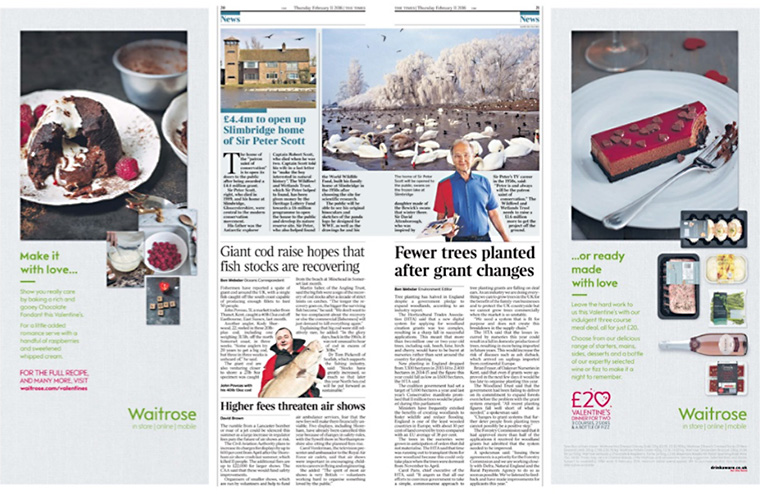From food to finance, print advertisements deliver strong results
Print Innovations | 30 March 2016
“Print is at the heart of any Waitrose plan,” stated Manning Gottlieb OMD’s Tim Pearson at Newsworks’ Shift 2016 conference, held at the British Library earlier this month.
It goes without saying that Waitrose delivers impactful and often hunger-inducing print advertisements in newspapers — just look at the panoramic Christmas ad that ran in The Telegraph and The Sunday Times, and was shortlisted for Newsworks’ 2015 Planning Awards.
Not only did it look gorgeous, but the innovative format contributed to 60% of consumers recalling the ad and 55% agreeing that it made them want to buy one of the featured products, according to post-campaign research with a Telegraph reader panel.

The supermarket memorably also launched its “Pick Your Own Offers” campaign with seven different wraps of the Evening Standard, all distributed on the same day to demonstrate the array of products shoppers could choose from.
A year on and Waitrose is still utilising print to great effect. According to Pearson: “Print is our most effective ROI channel. It really does deliver commercial value back to the partnership. But it goes beyond just ROI. News is consistently in the top two channels when it comes to brand and conversion metrics.”
Giving further insight into this “powerful and influential channel,” adam&eveBBD’s Tammy Einav went on to detail how newspapers, in both their print and digital forms, “allow us to tell a number of stories at any one time” and engage consumers with different messages via a consistent handwriting.

Focusing on the supermarket’s most recent seasonal campaigns, Einav demonstrated how an “in-newspaper domination” was created by adopting a mosaic approach to images. Clever use of format to mirror content was also demonstrated with Valentine’s Day bookends, depicting what Waitrose had to offer those inclined to cook versus those favouring a ready-made option.
The effectiveness and opportunities print offers has similarly been demonstrated at Newsworks events by the likes of 101’s Laurence Green, MEC’s James Appleby, and adam&eveDDB’s James Murphy.
Speaking at the People’s History museum last October, Green took to the stage to present a case study on how Scottish Widows utilised news brands as part of a multi-media campaign to modernise the brand.
With the campaign focusing on “the joy of life when we’ve made a plan,” Green said that print “enabled us to tell the story in so many different ways.” News brands emerged as the highest performer of the campaign, pound for pound.
In a follow-up campaign focused on creating action, print not only drove most visits to an online hub but the traffic it generated also visited more pages.
Green added: “I think the newspaper industry occasionally does itself a disservice by forgetting that it serves extraordinary readers with engaged and attentive minds, rather than trying to battle others in the user count.”
Print’s ability to tell stories and engage readers was similarly highlighted by MEC’s Appleby at a previous Shift North conference. Discussing Halifax’s advertising strategy, Appleby said that the synergy readers have with their newspaper, as well as the impact and flexibility print offers, is of value to clients.
The combination of stand-out formats to engage readers’ attention and print’s “inherent ability to convey detail” has provided the right environment for Halifax to communicate its offers and plans.
In a world where it “feels like everything is speeding up and news is instant and the amount of space you have on your screen is smaller,” Appleby pointed out that with print “people are hanging around on a page long enough to actually read what you’ve got to say.”
Having opened with Waitrose, it seems fitting to conclude with its sister brand John Lewis. Manning Gottlieb OMD’s Pearson was joined by adam&eveBBD’s James Murphy at Newsworks’ second annual Shift London conference to discuss the “fantastic toolbox” news brands offer a company famous for its Christmas television ads.
The John Lewis case study provided an interesting insight into how the retailer uses different media to convey different levels of tonality, with quite nuanced and detailed stories being told “in media where people have more dwell time.”
On a day-to-day basis, news brands, including print, allow Lewis to build the brand and control the conversation. As Murphy said, it’s “the backbone of what’s being done to drive this large and quite layered business forward.”
So from food to finance to fashion, the above case studies show that print plays an essential role for a range of advertisers. Whether it’s engaging readers with detailed messages; creating impact with innovative, thoughtful formats; or benefitting from the flexibility to create topical and contextual ads, print is proven time and again to be an effective and influential medium, which more than holds its own in our digital landscape.































